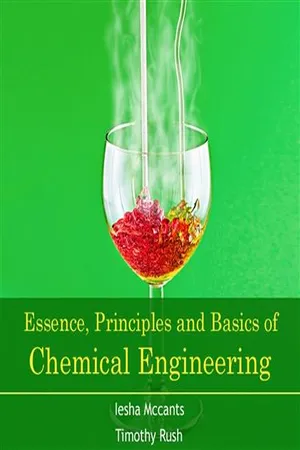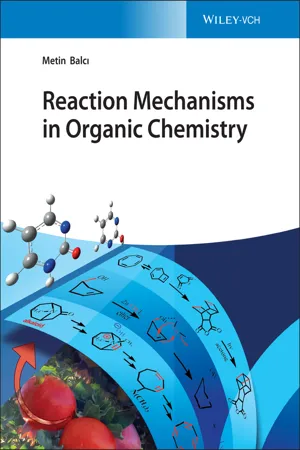Chemistry
Addition Reaction
An addition reaction is a chemical process in which two or more substances combine to form a single product. This reaction typically involves the breaking of multiple chemical bonds and the formation of new bonds. Addition reactions are commonly seen in organic chemistry, where they play a key role in the synthesis of various compounds.
Written by Perlego with AI-assistance
Related key terms
1 of 5
4 Key excerpts on "Addition Reaction"
- eBook - PDF
- John A. Olmsted, Gregory M. Williams, Robert C. Burk(Authors)
- 2020(Publication Date)
- Wiley(Publisher)
However, the number of distinctly different types of organic reactions is surprisingly small. In this chapter, we will study three important types of reactions; namely, substitution, elimination, and Addition Reactions. In a substitution reaction, as the name suggests, one functional group is substituted for another. An example is shown below, where a nitro group substitutes for a hydrogen atom on a benzene ring: HNO 3 NO 2 H 2 O H 2 SO 4 + + In an elimination reaction, atoms or groups of atoms that are bound to adjacent carbon atoms are eliminated, generally as a small molecule. This results in the formation of a double bond between the carbon atoms. For example, ethanol can undergo a reaction to form ethene with the elimination of water: H OH H H H H H H H H H 2 O + And finally, in an Addition Reaction, a molecule is added across a double (or triple) bond, resulting in a single (or double) bond. An example is the chlorination of ethene to make 1,2-dichloroethane: Cl Cl H H H H H H H H Cl 2 + Chemical Space—How Many Possible Drug Compounds Are There? New drug molecules have been synthesized and tested by the thou- sands over the years. However, recent estimates suggest that only a tiny fraction of the potential medicines that could be made have been synthesized so far. Some estimates suggest that there are as many as 10 60 potentially interesting small molecules that we have yet to synthesize or test. This staggering number is not too different from estimates of the number of atoms in the universe—how can we possibly decide which compounds to spend time and effort on? Combinatorial chemistry involves the automated synthesis of huge libraries of different but related compounds. Pharmaceu- tical companies in particular have used robotic approaches to syn- thesize hundreds of thousands of new and unique compounds per year. - No longer available |Learn more
- (Author)
- 2014(Publication Date)
- Academic Studio(Publisher)
Chapter 8 Chemical Reaction A thermite reaction using ferric oxide A chemical reaction is a process that leads to the transformation of one set of chemical substances to another. Chemical reactions can be either spontaneous, requiring no input of energy, or non-spontaneous, typically following the input of some type of energy, viz. heat, light or electricity. Classically, chemical reactions encompass changes that strictly involve the motion of electrons in the forming and breaking of chemical bonds, although the general concept of a chemical reaction, in particular the notion of a chemical equation, is applicable to transformations of elementary particles, as well as nuclear reactions. ___________________WORLD TECHNOLOGIES____________________ The substance (or substances) initially involved in a chemical reaction are called reactants or reagents. Chemical reactions are usually characterized by a chemical change, and they yield one or more products, which usually have properties different from the reactants. Reactions often consist of a sequence of individual sub-steps, the so-called elementary reactions, and the information on the precise course of action is part of the reaction mechanism. Chemical reactions are described with chemical equations, which graphically present the starting materials, end products, and sometimes intermediate products and reaction conditions. Different chemical reactions are used in combination in chemical synthesis in order to obtain a desired product. In biochemistry, series of chemical reactions catalyzed by enzymes form metabolic pathways, by which syntheses and decompositions impossible under ordinary conditions are performed within a cell. History Antoine Lavoisier developed the theory of combustion as a chemical reaction with oxygen Chemical reactions such as combustion in the fire, fermentation and the reduction of ores to metals were known since antiquity. - eBook - ePub
Active Pharmaceutical Ingredients in Synthesis
Catalytic Processes in Research and Development
- Anthony J. Burke, Carolina Silva Marques, Nicholas J. Turner, Gesine J. Hermann(Authors)
- 2018(Publication Date)
- Wiley(Publisher)
5 Catalytic Addition ReactionsWe think that when they get to the market, they're going to make a differenceLilly CEO John Lechleiter (2011), also stating that new drugs are based merely on “well‐founded hypotheses”5.1 Introduction
The carbon–carbon π‐bond of an alkene is relatively weak, and can be easily broken, making it quite reactive. Addition Reactions are generally considered as reactions in which reagents are added to alkenes, through the formation of new single bonds to carbon, thus becoming partially or wholly saturated [1] . Examples of this general and so frequently applied reaction are hydrogenation reactions, hydroboration, cyclopropanation, etc. (most of these topics are covered in detail in other chapters of this book). In this chapter, we look at examples of active pharmaceutical ingredient (API ) synthesis (and promising target compounds) where Addition Reactions were the key step. We only consider the so‐called 1,2‐Addition Reactions to carbonyls (and other C=X bonds), since “simple” alkenes do not show 1,2‐reactivity due to lack of polarity. The well‐known aldol‐type reaction is an example of a nucleophilic Addition Reaction of an enolate (nucleophile) to a carbon of a carbonyl group (a good electrophile) and thus is considered here. The other type of addition discussed here is the so‐called 1,4‐Addition Reaction (or conjugated Addition Reaction), where a conjugated system is involved. Conjugate Addition Reactions are one of the largest and most diverse reactions in organic chemistry and possess a relatively extensive history.In 1883, Komnenos reported the addition of diethyl sodium‐malonate to diethyl ethylidenemalonate and this was the first example of a conjugate Addition Reaction [2] , but its mechanism was delineated only later [3] - eBook - PDF
- Metin Balcı(Author)
- 2021(Publication Date)
- Wiley-VCH(Publisher)
133 4 Addition Reactions to Alkenes An Addition Reaction is a chemical reaction in which two or more compounds come together to form a larger compound. However, only chemical compounds containing multiple bonds such as C=C (or C=O) double bonds or C≡C triple bonds can undergo an Addition Reaction. Two new σ-bonds are formed during this reaction, and a double or triple bond is usually broken to form the required single bonds. A double bond consists of a σ-bond and a π-bond. A σ-bond is more stable than a π-bond because in the former, the bonding takes place in the direction of the axis connecting the two atoms, while in the latter, the p orbitals interfere above and below the plane that forms a double bond. Therefore, this interference is not as effective as in σ-bonds. Thus, π-bonds are less stable, and the most common reactions of double bonds transform π-bonds into σ-bonds. A general Addition Reaction to a C=C double bond is given below. C R 2 R 2 R 1 H C H R 1 A–B C H C H B A Addition Reaction We can classify Addition Reactions in two groups according to the polarity of the reactions: Polar Addition Reactions, namely: Electrophilic Addition Reactions Nucleophilic Addition Reactions Nonpolar Addition Reactions, namely: Free radical Addition Reactions Cycloadditions reactions In this chapter, we will discuss electrophilic Addition Reactions to C=C double bonds and C≡C triple bonds. The electron density between two carbon atoms of a double bond is high. Therefore, alkenes show nucleophilic properties and act as nucleophiles in Addition Reactions. Because of this feature of alkenes, compounds with an electron deficiency, i.e. electrophiles, can be readily attacked by double-bond electrons. In this section, we will focus mainly on the reaction of alkenes with electrophiles. The question arises here, Can alkenes react with nucleophiles? For alkenes to react with nucleophiles, it is essential to decrease the electron density in the double bond.
Index pages curate the most relevant extracts from our library of academic textbooks. They’ve been created using an in-house natural language model (NLM), each adding context and meaning to key research topics.



